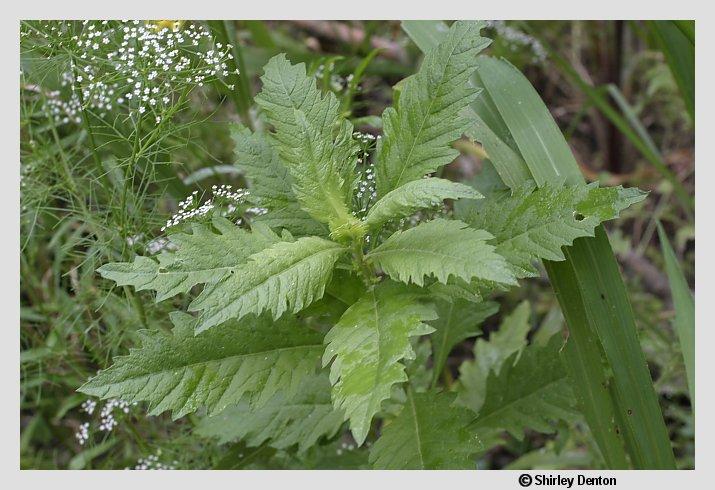| Please scroll to the bottom for more images. |
Chenopodium ambrosioides
L.
Mexican tea
|

Copyright by: Shirley Denton
Family: Amaranthaceae
Group: Dicot
Substrate:
Terrestrial
Habit:
Herb
Perennation:
Short Lived Perennial
Native Range: Perhaps Mexico, Central America and South America, but it's origins obscured through cultivation; widely cultivated and naturalized elsewhere.
Map of select IRC data for peninsular Florida
SOUTH FLORIDA Occurrence:
Present
SOUTH FLORIDA Native Status:
Not Native, Naturalized
SOUTH FLORIDA Cultivated Status:
Not Cultivated
Synonyms: C. anthelminticum.
|
| Other data on Chenopodium ambrosioides available from : |
|
|
Chenopodium ambrosioides
has been found in the following
47 conservation areas
:
|
|
Occurrence
|
Native Status
|
|
A.D. Doug Barnes Park
|
Present
|
Not Native, Naturalized
|
|
Arthur R. Marshall Loxahatchee National Wildlife Refuge
|
Present
|
Not Native, Naturalized
|
|
Big Cypress National Preserve
|
Present
|
Not Native, Naturalized
|
|
Bill Baggs Cape Florida State Park
|
Present
|
Not Native, Naturalized
|
|
Coconut Creek Maple Swamp Natural Area
|
Present
|
Not Native, Naturalized
|
|
County Line Scrub, Miami-Dade County
|
Present
|
Not Native, Naturalized
|
|
Crandon Park
|
Present
|
Not Native, Naturalized
|
|
Curry Hammock State Park
|
Reported
|
|
|
Delray Oaks Natural Area
|
Present
|
Not Native, Naturalized
|
|
Dr. Von D. Mizell-Eula Johnson State Park
|
Possibly Extirpated
|
Not Native, Naturalized
|
|
Dupuis Reserve
|
Present
|
Not Native, Naturalized
|
|
Florida Atlantic University Ecological Site
|
Present
|
Not Native, Naturalized
|
|
Fred C. Babcock-Cecil M. Webb Wildlife Management Area
|
Present
|
Not Native, Naturalized
|
|
Frenchman's Forest Natural Area
|
Present
|
Not Native, Naturalized
|
|
High Ridge Scrub Natural Area
|
Present
|
Not Native, Naturalized
|
|
Hillsboro Pineland Natural Area
|
Present
|
Not Native, Naturalized
|
|
Hobe Sound National Wildlife Refuge
|
Present
|
Not Native, Naturalized
|
|
Hugh Taylor Birch State Park
|
Present
|
Not Native, Naturalized
|
|
J.W. Corbett Wildlife Management Area
|
Present
|
Not Native, Naturalized
|
|
John D. MacArthur Beach State Park
|
Present
|
Not Native, Naturalized
|
|
Jonathan Dickinson State Park
|
Present
|
Not Native, Naturalized
|
|
Juno Dunes Natural Area
|
Present
|
Not Native, Naturalized
|
|
Jupiter Inlet Lighthouse Outstanding Natural Area
|
Present
|
Not Native, Naturalized
|
|
Jupiter Ridge Natural Area
|
Present
|
Not Native, Naturalized
|
|
Long Key Natural Area & Nature Center
|
Present
|
Not Native, Naturalized
|
|
Long Key State Park
|
Reported
|
|
|
Miramar Pineland
|
Present
|
Not Native, Naturalized
|
|
Muscara
|
Present
|
Not Native, Naturalized
|
|
Navy Wells Pineland 23
|
Present
|
Not Native, Naturalized
|
|
Nicodemus Slough
|
Present
|
Not Native, Naturalized
|
|
Okeeheelee Park
|
Present
|
Not Native, Naturalized
|
|
Oleta River State Park
|
Present
|
Not Native, Naturalized
|
|
Pine Island Ridge Natural Area
|
Present
|
Not Native, Naturalized
|
|
Pond Apple Slough Natural Area
|
Present
|
Not Native, Naturalized
|
|
Prairie Pines Preserve
|
Present
|
Not Native, Naturalized
|
|
Rookery Bay National Estuarine Research Reserve
|
Present
|
Not Native, Naturalized
|
|
Rosemary Scrub Natural Area
|
Present
|
Not Native, Naturalized
|
|
Santa Lucea
|
Present
|
Not Native, Naturalized
|
|
Savannas Preserve State Park
|
Present
|
Not Native, Naturalized
|
|
Scrub Oak Park
|
Present
|
Not Native, Naturalized
|
|
Seabranch Preserve State Park
|
Present
|
Not Native, Naturalized
|
|
Seacrest Scrub Natural Area
|
Present
|
Not Native, Naturalized
|
|
Tall Cypress Natural Area
|
Present
|
Not Native, Naturalized
|
|
Tree Tops Park
|
Present
|
Not Native, Naturalized
|
|
Twin Rivers
|
Present
|
Not Native, Naturalized
|
|
Wild Turkey Strand Preserve
|
Present
|
Not Native, Naturalized
|
|
Yamato Scrub Natural Area
|
Present
|
Not Native, Naturalized
|
|
All Images:
|
|

Copyright by: Shirley Denton
|
|
|
